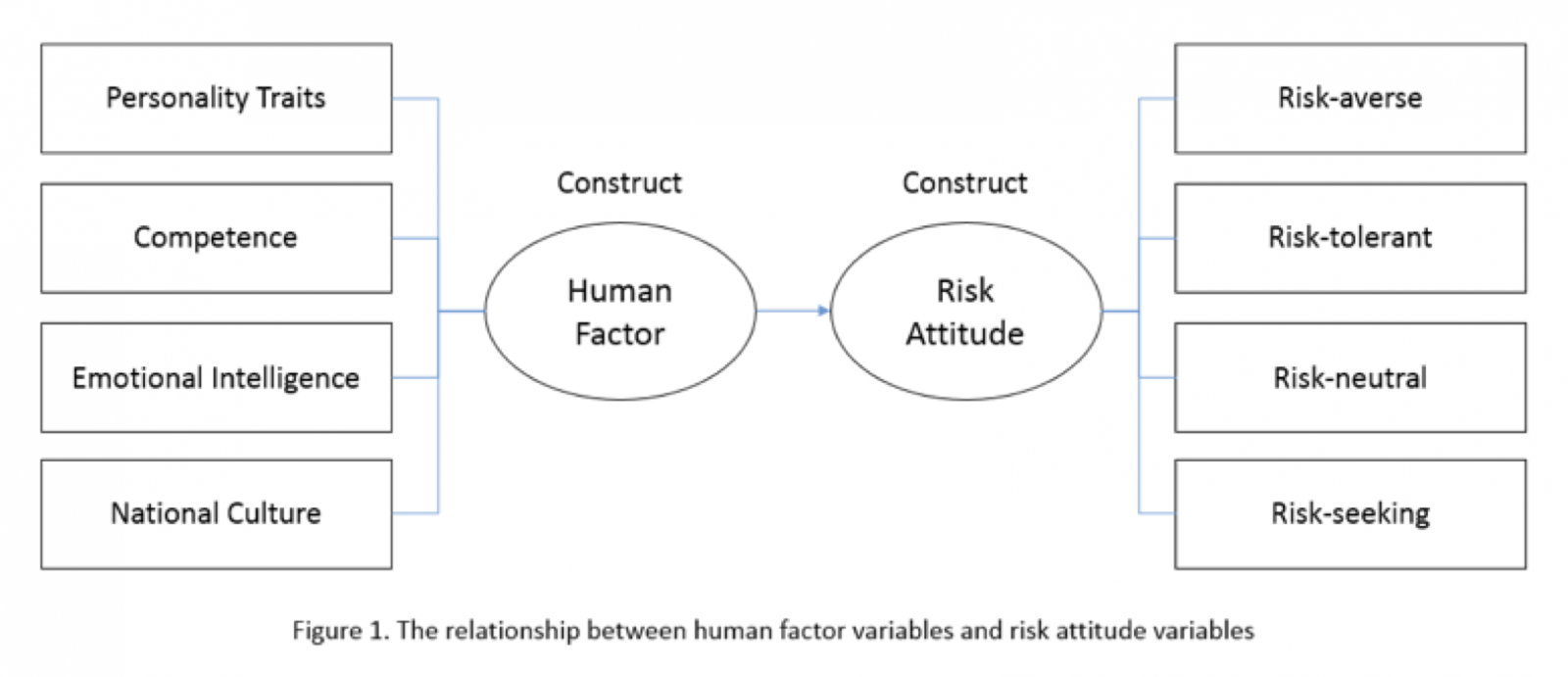The Influence of Human Factors on Risk Attitudes

Introduction
Risk is inevitable in projects and there is no such a thing as a risk-free project. The question that should be researched is not whether there is a risk or not, but rather what are the factors that influence project team members’ risk attitudes and hence their risk response planning. Risk attitudes are influenced by many factors such as: individual, group, organizational and situational factors. In addition, risk attitudes are also highly influenced by human factors related to the project team members. The purpose of this article is to investigate and understand the relationship between project team members’ human factors and their potential risk attitude in order to guide project practitioners to plan the appropriate risk responses.
Human Factors Influencing Risk Attitudes
There are many Critical Success Factors (CSFs) that influence the effectiveness of risk management, yet there is almost unanimity among project and risk practitioners about the most significant CSF for risk management: “human factors”. Human factors can be defined as individual, group and organizational factors that impact the achievement of project goals by influencing project team members’ behavior. Individual factors can refer to competence, motivation level, emotional intelligence and cultural background, group factors can refer to leadership styles, communication methods, coordination and empowerment, and organizational factors can refer to corporate policies, procedures and senior management style.
Although, there are other names for “human factors” such as “soft elements” or “human aspects”, team members must acknowledge them as the most important contributors to risk management effectiveness. After all, risk management is not only mathematical calculations or data analysis but an iterative process that requires human judgement in all its steps which are: initiate, identify, assess, plan responses and implement risk responses.
Since the aim of this article is to study the influence of human factors on risk attitude, the following human factors relating to project team members will be explored: personality traits, competence, emotional intelligence and national culture. See figure .1 for the proposed conceptual model.
Personality Traits
There is no single definition of personality or the traits that make it up. Personality can be defined as something that describes human behavioral and emotional characteristics that could have been inherited or developed through social interactions. Understanding personality allows for a better prediction of individuals’ responses to project risks. It is vital to study the effect of personality traits on risk attitudes by adopting a personality model that focuses on traits rather than on the situational or environmental factors.
Competence
There are many definitions for human competence. Worker-oriented approaches describe competence as attributes controlled by humans and classically represented as knowledge, skills and abilities (KSAs). Additionally, a job competency can be defined as the individual’s fundamental characteristics, showing itself in the form of traits, skills, and knowledge. Project team members’ attitude towards risk can be affected by their level of competence, where limited competence can lead to a risk-averse attitude and vice versa. In addition, individuals’ risk perception is also affected by their level of competence since their estimation of their own skill and competence can influence their risk attitude. Moreover, individuals who feel uncertain and incompetent tend to overestimate risk while those who perceive themselves as knowledgeable, experienced and competent tend to underestimate it. Therefore, individuals confronting uncertain situations of which they have no prior knowledge nor experience tend to perceive the situation as risky which leads to a more risk-averse response. In contrast, individuals adopt more risk-seeking attitudes when faced with a situation where they have proven skills or
Emotional Intelligence
Same as with the term “risk”, there is no wide agreement on the definition of the term “emotion”. Definitions for “emotion” in dictionaries range from considering it as a disturbance of mind to a mental sensation or state. Nevertheless, there is general agreement that emotions can be understood, managed and used for achieving success. Hillson and Murray-Webster (2007) defined emotions as a term referring to all those extrinsic feelings that are thought of or voiced out. Emotional intelligence however, can be defined as the ability to observe, express and manage emotions within oneself and in relationship with others. Emotional intelligence can consist of two sets of competencies: personal and social. The personal competencies consist of self-awareness, confidence, self-regulation, conscientiousness, and motivation while social competencies consist of empathy and social skills.
Emotions can either assist project team members in managing project risks or it can be a burden. Furthermore, all risk processes can be affected by the emotional intelligence of project stakeholders at both individual and group levels. Therefore, it is imperative for project professionals to develop their emotional intelligence since it has a direct impact on the effectiveness of risk management.
National Culture
The national culture environment within which the project team members operate has a major influence on risk attitudes. There is no general agreement about the meaning of the word “culture” with many sociologists and anthropologists defining it in different ways. Culture could be defined as the learned beliefs, norms, and traditions that are shared among a group of individuals. Hofstede (2001) broke down national cultural differences into five independent dimensions: power distance, individualism /collectiveness, masculinity /femininity, uncertainty avoidance and time orientation. Although all five dimensions can be related to risk attitude, the most relevant one is the uncertainty avoidance dimension which has to do with the degree to which a culture influences its members to feel either comfortable or uncomfortable when facing unstructured or risky situations. It also refers to the level a society, organization or individual depends on recognized social standards and procedures to avoid uncertainty by making things more predictable. Uncertainty avoidance indicates also the level of threat individuals might feel in an uncertain event and the extent to which they might seek to avoid this uncertainty. Finally, Hofstede (2001) calculated an uncertainty avoidance index (UAI) for fifty countries where the Arab countries (including UAE) score was 68, indicating medium tendency for desiring certainty. A high UAI links to a risk-averse attitude while a low UAI links to a risk-seeking attitude.
Risk Attitudes
Effective project risk management systems are implemented by individuals and therefore, the risk attitude of these individuals can have an important impact on the successful implementation of risk systems. International research in psychology indicate that individuals’ attitude towards risk can contain some biases that result in inappropriate responses to risks. In line with the above, the PMBOK Guide (2013) emphasized that risk attitude can include many aspects such as risk appetite, risk threshold and risk tolerance. All these aspects might influence the way individuals and organizations respond to risks. Although there is no agreement on a single definition of risk attitude, they all relate to the mindset selected as a response to uncertainties driven by the perception of individuals
Risk attitudes can be classified into four broad categories: risk-averse, risk-tolerant, risk-neutral and risk-seeking. These four risk attitudes can influence key points in the risk management process ranging from risk identification to risk assessment and risk response planning. Below is a brief description of the four risk attitudes:
Risk-averse: refers to the person feeling uncomfortable with uncertainty, having low tolerance for ambiguity and seeking safety when facing risk. People with risk-averse attitude tend to over-react to negative risks and under-react to positive risks.
Risk-tolerance: refers to the person being sensibly comfortable with most uncertainty, accepting the fact that it exist in life and projects. People with a risk-tolerant attitude tend to accept uncertainty without letting it have a major impact on their behavior.
Risk-neutral: refers to the person not being risk-averse or risk-seeking but rather seeking plans that have high future pay-offs. People with risk-neutral attitude tend to focus on the longer term and take actions that lead to major benefits.
Risk-seeking: refers to the person being adaptable to risks and not afraid of taking action. People with a risk seeking attitude tend to enjoy threats and risks and look at them as challenges.
Project Risk Responses Planning
There are strategies for dealing with negative risks as well as positive risks. The strategies that deal with negative risks are: avoid, mitigate and transfer. The chosen risk strategy should match the probability of the risk occurring and its impact should it occur. The strategies used for dealing with positive risks are: exploit, enhance and share. A common fourth strategy that can be used in dealing with negative or positive risks is the acceptance of threats and opportunities without taking any action. The above-mentioned risk responses may split into proactive and reactive options, but an organization can only be successful if it adopts a proactive and consistent approach for managing project risks. Although risk response categorization could be helpful in the assignment of risk responses to identified risks, it might be an over simplification because many risks need to be dealt with by using a combination of responses.
Finally, the selection of appropriate risk responses should consider how these responses affect other projects. Choosing the optimal risk responses among many alternatives requires knowledge about the outcomes of activities preceding the selected actions. Furthermore, risk responses are shaped by the project team members’ abilities to predict potential opportunities and threats as well as their risk attitudes.
References
Hillson, D. & Murray-Webster, R. (2007). Understanding and Managing Risk Attitude. Burlington, USA: Gower.
Hofsetde, G.H (2001). Culture’s Consequences: Comparing vales, behaviors, institutions, and organizations across nations. 2nd edn. Sage Publications: California, US.
Project Management Body of Knowledge (PMBOK) Guide (2013). Project Management Institute.
Related Articles

The illusion of control: Unmasking the Paradox of Readiness
Mike Tyson famously said: “Everybody has a plan until they get punched…

Unlocking Business Wisdom: Khalil Gibran's Timeless Insights
Gibran Khalil Gibran was a renowned Lebanese American poet, writer, and…

Am I Mr. Nice Guy or A People-pleaser?
I wanted to share a question that's been on my mind. I recently listened…

My adventure in the world of virtual learning
The traditional concept of education has changed radically over the past…
